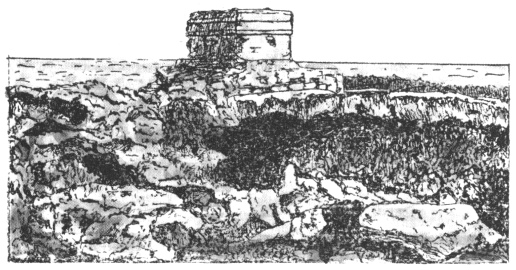
ISLA DE LAS MUGERES. Photo by Maler
Yucatan Before and After the Conquest, by Diego de Landa, tr. William Gates, [1937], at sacred-texts.com
This province is called in the language of the Indians Ulumil cuz yetel ceh, meaning 'the land of the turkey and the deer.' It is also called Petén, meaning 'island,' an error arising from the gulfs and bays we have spoken of. †
When Francisco Hernández de Córdoba came to this country and landed at the point he called Cape Cotoch, he met certain Indian fisherfolk whom he asked what country this was, and who answered Cotoch, which means 'our houses, our homeland,' for which reason he gave that name to the cape. When he then by signs asked them how the land was theirs, they replied Ci uthan, meaning 'they say it,' ‡ and from that the Spaniards gave the name Yucatan. This was learned from one of the early conquerors, Blas Hernández, who came here with the admiral on the first occasion.
In the southern part of Yucatan are the rivers of Taiza (Tah-Itzá) and the mountains of Lacandón, and between the south and west lies the province of Chiapas; to pass thither one must cross four streams that descend from the mountains and unite with others to form the San Pedro y San Pablo river discovered by Grijalva in Tabasco. To the west lie Xicalango and Tabasco, one and the same province.
Between this province of Tabasco and Yucatan there are two sea mouths breaking the coast; the largest of these forms a vast lagoon, while the other is of less extent. The sea enters these mouths with such fury as to create a great lake abounding in fish of all kinds, and so full of islets that the Indians put signs on the trees to mark the way going or coming by boat from Tabasco to Yucatan. These islands with their shores and sandy beaches have so great a variety of seafowl as to be a matter of wonder and beauty; there is an infinite amount of game: deer, hare, the wild pigs of that country, and
monkeys as well, which are not found in Yucatan. The number of iguanas is astonishing. On one island is a town called Tixchel.
To the north is the island of Cuba, with Havana facing at a distance of 60 leagues; somewhat further on is a small island belonging to Cuba, which they call Isla de Pinos. At the cast lies Honduras, between which and Yucatan is a great arm of the sea that Grijalva called Ascension Bay; this is filled with islets on which many boats are wrecked, especially those in the trade between Yucatan and Honduras. Fifteen years ago a ship laden with many people and goods foundered, and all were drowned save one Majuelas and four others, who seized hold of a great piece of wood from the ship, and thus went three or four days without reaching any of the islets until their strength gave out and ail sank except Majuelas. He came out half dead and recovered himself eating snails and shellfish; then from the islet he reached the mainland on a balsa or raft which he made as best he could out of branches. Having come to land, and while hunting for food, he came upon a crab that bit off his thumb at the first joint, and caused him intense pain. Thence he set out through difficult bush to try to reach Salamanca, and when night came he climbed a tree from which he saw a great tiger waylay and kill a deer; then when morning came he ate what the tiger had left.
In front of Yucatan, somewhat below Cape Cotoch, lies Cuzmil (Cozumel), across a 5-league channel where the sea runs with a strong current between the mainland and the island. Cozumel is an island fifteen leagues long by five wide. The Indians are few in number, and of the same language and customs as those of Yucatan. It lies at the 20th degree of latitude. Thirteen leagues below Point Cotoch is the Isla de las Mugeres, 2 leagues off the coast opposite Ekab.

ISLA DE LAS MUGERES. Photo by Maler
2:* October 4th.
2:† Petén properly means district, region, circuit.
2:‡In common use today in Yucatan, meaning 'he speaks nicely, well.'